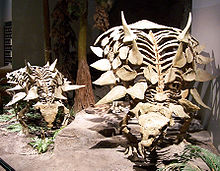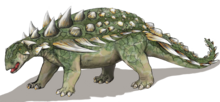Gastonia (dinosaur): Difference between revisions
J. Spencer (talk | contribs) aren't reconstructions usually not put in the box? |
m spelling |
||
| Line 11: | Line 11: | ||
| authority = Kirkland, 1998 |
| authority = Kirkland, 1998 |
||
}} |
}} |
||
'''''Gastonia''''' is a [[genus]] of [[nodosaurid]] [[dinosaur]] from the [[Early Cretaceous]] of [[North America]], around 125 million years ago. Closely related to ''[[Polacanthus]]'', it has a sacral shield and large shoulder spikes. It is also the first polacanthine dinosaur to have been mounted for display at the [[Denver Museum of Nature and Science]], together with the related ''[[Gargoyleosaurus]]''. This dinosaur was found in the same quarry as ''[[Utahraptor]]'', the largest known dromaeosaurid. It was named after US |
'''''Gastonia''''' is a [[genus]] of [[nodosaurid]] [[dinosaur]] from the [[Early Cretaceous]] of [[North America]], around 125 million years ago. Closely related to ''[[Polacanthus]]'', it has a sacral shield and large shoulder spikes. It is also the first polacanthine dinosaur to have been mounted for display at the [[Denver Museum of Nature and Science]], together with the related ''[[Gargoyleosaurus]]''. This dinosaur was found in the same quarry as ''[[Utahraptor]]'', the largest known dromaeosaurid. It was named after US palaeontologist [[Rob Gaston]].<ref name="Benton, Michael J, Prehistoric Life">{{cite book|last=Benton|first=Michael J.|title=Prehistoric Life|year=2012|publisher=Dorling Kindersley|location=Edinburgh, Scotland|isbn=978-0-7566-9910-9|page='''334'''|url=http://www.dk com}}</ref> |
||
==Discovery and species== |
==Discovery and species== |
||
Revision as of 17:20, 22 January 2014
| Gastonia Temporal range: Early Cretaceous,
| |
|---|---|

| |
| Skeletons at the North American Museum of Ancient Life. | |
| Scientific classification | |
| Domain: | Eukaryota |
| Kingdom: | Animalia |
| Phylum: | Chordata |
| Clade: | Dinosauria |
| Clade: | †Ornithischia |
| Clade: | †Thyreophora |
| Clade: | †Ankylosauria |
| Family: | †Nodosauridae |
| Subfamily: | †Polacanthinae |
| Genus: | †Gastonia Kirkland, 1998 |
| Species: | †G. burgei
|
| Binomial name | |
| †Gastonia burgei Kirkland, 1998
| |
Gastonia is a genus of nodosaurid dinosaur from the Early Cretaceous of North America, around 125 million years ago. Closely related to Polacanthus, it has a sacral shield and large shoulder spikes. It is also the first polacanthine dinosaur to have been mounted for display at the Denver Museum of Nature and Science, together with the related Gargoyleosaurus. This dinosaur was found in the same quarry as Utahraptor, the largest known dromaeosaurid. It was named after US palaeontologist Rob Gaston.[1]
Discovery and species


Named by James Kirkland in 1998 from material recovered in Grand County Utah, more complete material exists for Gastonia than for any other polacanthine ankylosaur.[1] Unfortunately, a wealth of disarticulated material from a bonebed presents problems as it can be hard to tell how many spikes a particular Gastonia actually had.[1] Gastonia was named after Robert Gaston, the discoverer of the genus. Robert Gaston is a paleoartist, who makes a living from creating museum quality casts and replicas of fossils for private and public collections.
The type species, G. burgei, was found in rocks of the Cedar Mountain Formation (Yellow Cat member), which has been dated to 126 million years ago.[2]
In popular culture
- Gastonia was featured in a chapter of Raptor Red, Robert T. Bakker's fictional account of the events in the life of a female Utahraptor. Bakker described defense behaviors as an Acrocanthosaurus attacks a young Gastonia (without success). Later in the novel, male Gastonia are shown to compete in leks, and losers wallow in shallow pools, sometimes exposing their armor-free bellies. Such behavior was speculation informed by modern animals and not based directly on fossil evidence.[3]
- Gastonia appears in an episode of Jurassic Fight Club, where it fights a Utahraptor.
References
- ^ a b c Benton, Michael J. (2012). com Prehistoric Life. Edinburgh, Scotland: Dorling Kindersley. p. 334. ISBN 978-0-7566-9910-9.
{{cite book}}: Check|url=value (help) - ^ Kirkland, J.I. and Madsen, S.K. 2007. The Lower Cretaceous Cedar Mountain Formation, eastern Utah: the view up an always interesting learning curve. Fieldtrip Guidebook, Geological Society of America, Rocky Mountain Section. 1-108 p.
- ^ Bakker, Robert (1996). Raptor Red (paperback ed.). Bantam Books. p. 4. ISBN 0-553-57561-9.
{{cite book}}: Unknown parameter|month=ignored (help)
- Gaston, R.W., Scellenbach, J., Kirkland, J.I. (2001). "Mounted skeleton of the Polacanthine Ankylosaur Gastonia burgei". In Carpenter, Kenneth(ed) (ed.). The Armored Dinosaurs. Indiana University Press. pp. 386–398. ISBN 0-253-33964-2.
{{cite book}}:|editor=has generic name (help)CS1 maint: multiple names: authors list (link)
- Blows, W.T. (2001). "Dermal Armor of Polacanthine Dinosaurs". In Carpenter, Kenneth(ed) (ed.). The Armored Dinosaurs. Indiana University Press. pp. 363–385. ISBN 0-253-33964-2.
{{cite book}}:|editor=has generic name (help)
